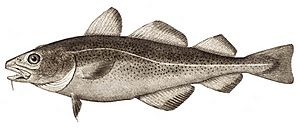Quick facts for kids Atlantic cod |
 |
| Conservation status |
|
|
| Scientific classification |
 |
| Distribution of Atlantic cod |
| Synonyms |
- Asellus major
- Gadus callarias Linnaeus, 1758
- Gadus vertagus Walbaum, 1792
- Gadus heteroglossus Walbaum, 1792
- Gadus ruber Lacepède, 1803
- Gadus arenosus Mitchill, 1815
- Gadus rupestris Mitchill, 1815
- Morhua vulgaris Fleming, 1828
- Morhua punctatus Fleming, 1828
- Gadus nanus Faber, 1829
- Morrhua americana Storer, 1839
|
Atlantic cod is a species of cod which occurs in the northern part of the Atlantic Ocean. The younger fish live near the surface of the ocean, the older ones near the sea floor. Atlantic cod is one of the species of cod that has been consumed by humans. The atlantic cod feeds on other, smaller fish (for example herring), as well as molluscs.
Images for kids
-
Atlantic cod in a High Arctic Lake in Canada. These cod resemble those of past Atlantic catches. Measuring 47–53 in (120–130 cm) long and weighing between 44 and 57 lb (20 and 26 kg), it is easy to see that today's 16–20 in (41–51 cm) commercially caught cod are less than half this size.
-
Reported landings of Atlantic cod (Gadus morhua) in the eastern Atlantic for each of the 16 populations/management units. Data source: ICES.
-
Landings of Atlantic cod (Gadus morhua) in the western Atlantic from 1960 to 2019. Data source: NAFO.
-
Estimated biomass of the Northeast Arctic cod stock for the period 1946–2012, in million tons: Light blue bars represent the immature fraction of the stock, while the darker blue bars represent the spawning biomass.
-
Spawning female in captivity
-
-
See also
 In Spanish: Bacalao para niños
In Spanish: Bacalao para niños


 In Spanish: Bacalao para niños
In Spanish: Bacalao para niños








